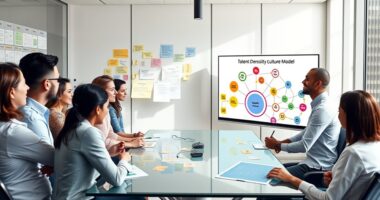Ageism can hinder your opportunities in fast-changing industries, but you can challenge these barriers by embracing continuous learning, updating your skills, and demonstrating adaptability. Sharing your experience through mentorship helps break stereotypes and fosters mutual respect. Actively engaging with new technologies and building inclusive relationships showcase your value and commitment. If you want practical strategies to overcome age-based biases and thrive in dynamic workplaces, there’s more to discover beyond this overview.
Key Takeaways
- Promote intergenerational mentorship to break stereotypes and foster mutual respect among workers of all ages.
- Encourage continuous learning and skill development to demonstrate adaptability and stay current with industry changes.
- Recognize and leverage the unique strengths and extensive experience of older workers to enhance organizational innovation.
- Implement inclusive policies that challenge ageist biases and create equal growth opportunities for all employees.
- Highlight success stories of older workers embracing new technologies to reshape perceptions of age and capability.

Despite advances in diversity and inclusion, ageism still limits opportunities for older adults in the workplace and beyond. Far too often, age-related stereotypes lead employers to overlook the valuable contributions older workers can offer. You might find that assumptions about outdated skills or resistance to change hinder your chances of advancing in dynamic industries. But there’s a powerful way to challenge these perceptions: engaging in intergenerational mentorship. When you share your experience with younger colleagues, you not only demonstrate your expertise but also foster collaboration and mutual respect. This exchange helps break down age-related barriers, showing that wisdom and innovation go hand in hand. Additionally, embracing skill adaptation becomes essential. Industries evolve rapidly, and staying current requires continuous learning. You’re encouraged to seek out training opportunities, whether through online courses, workshops, or on-the-job learning. By actively updating your skills, you counteract stereotypes that older adults resist change. Instead, you position yourself as adaptable and committed to growth. This proactive approach not only boosts your confidence but also signals to employers that you’re ready to contribute in new and meaningful ways. Recognizing your unique strengths allows you to leverage your experience while embracing new technologies and methods. For example, digital tools might seem intimidating at first, but with persistence and support, you can master them and demonstrate your relevance in the modern workplace. The key is to view skill adaptation as an ongoing process rather than a one-time effort. Incorporating emerging technologies, such as AI tools, can further enhance your capabilities and keep you competitive. Combining this mindset with intergenerational mentorship creates a powerful synergy—you’re not just learning but also passing on your knowledge to others. This reciprocal relationship fosters a culture of continuous improvement, benefiting everyone involved. Employers increasingly value diverse perspectives, and your willingness to adapt and mentor can position you as a critical asset within your organization. It also helps you build meaningful relationships across generations, breaking down the ageist biases that often dominate workplace culture. Ultimately, by actively participating in intergenerational mentorship and committing to skill adaptation, you challenge the stereotypes that limit opportunities for older adults. You demonstrate that experience, combined with a growth mindset, can drive innovation and success. Your contributions can reshape perceptions, proving that age is not a barrier but an asset. Embracing these strategies empowers you to navigate the evolving landscape of your industry confidently, fostering a more inclusive environment where opportunities are accessible to all, regardless of age.
Frequently Asked Questions
How Can Companies Measure Age Diversity Effectively?
You can measure age diversity effectively by analyzing your workforce data to track the age distribution across departments and roles. Use metrics like the percentage of employees in different age groups and compare them to industry benchmarks. Conduct surveys to assess perceptions of workforce inclusion and identify gaps. Regularly reviewing these metrics helps you understand your age diversity, promote workplace inclusion, and make informed decisions to foster a more age-diverse environment.
What Technologies Are Helping Older Workers Stay Competitive?
Assistive technologies like ergonomic tools, speech recognition, and adaptive software help you stay competitive by reducing physical strain and increasing efficiency. Skill development platforms, online courses, and mentorship programs enable you to continuously learn new skills and adapt to evolving industry demands. These tools empower you to leverage your experience while staying current, ensuring you remain valuable and competitive in dynamic industries.
Are There Specific Industries More Receptive to Older Employees?
Some industries are like open arms, welcoming older workers with industry adaptability and age-friendly policies. Healthcare, education, and consulting often embrace a seasoned perspective, valuing experience over youth. These sectors see your skills as a sturdy bridge, connecting tradition with innovation. By fostering inclusive environments and flexible policies, they make it easier for you to thrive, proving that age is just a number in the dance of progress.
How Do Mentorship Programs Benefit Both Older and Younger Staff?
Mentorship programs foster intergenerational collaboration, benefiting both older and younger staff. You actively share your experience, helping younger employees develop skills and confidence. In turn, you gain fresh perspectives and stay engaged with new industry trends. This skill transfer strengthens team cohesion, boosts productivity, and creates a more inclusive workplace. Your involvement encourages mutual respect, enhances innovation, and guarantees valuable knowledge isn’t lost as the industry evolves.
What Legal Protections Exist Against Age Discrimination?
You have legal remedies against age discrimination through laws like the Age Discrimination in Employment Act (ADEA), which safeguards workers aged 40 and older. These laws prohibit employers from unfairly discharging, demoting, or refusing to hire based on age. If you face age discrimination, you can file a complaint with the Equal Employment Opportunity Commission (EEOC). Knowing your rights helps guarantee fair treatment and encourages workplaces to value all experience.
Conclusion
By challenging ageism, you open doors like a key turning smoothly in a lock, revealing opportunities for older workers to thrive in dynamic industries. Embracing diversity in age not only enriches your workplace but also fuels innovation and resilience. Remember, experience is a treasure chest, and when you support older employees, you’re revealing its full potential. Together, you can build a future where opportunity shines brightly for everyone, regardless of age.









